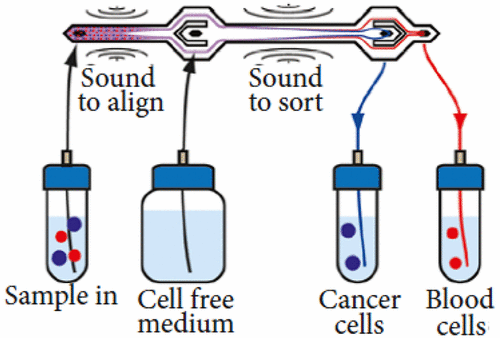当前位置:
X-MOL 学术
›
Anal. Chem.
›
论文详情
Our official English website, www.x-mol.net, welcomes your feedback! (Note: you will need to create a separate account there.)
Clinical-Scale Cell-Surface-Marker Independent Acoustic Microfluidic Enrichment of Tumor Cells from Blood
Analytical Chemistry ( IF 7.4 ) Pub Date : 2017-11-09 00:00:00 , DOI: 10.1021/acs.analchem.7b01458 Cecilia Magnusson , Per Augustsson , Andreas Lenshof , Yvonne Ceder , Thomas Laurell 1 , Hans Lilja 2, 3
Analytical Chemistry ( IF 7.4 ) Pub Date : 2017-11-09 00:00:00 , DOI: 10.1021/acs.analchem.7b01458 Cecilia Magnusson , Per Augustsson , Andreas Lenshof , Yvonne Ceder , Thomas Laurell 1 , Hans Lilja 2, 3
Affiliation

|
Enumeration of circulating tumor cells (CTCs) predicts overall survival and treatment response in metastatic cancer, but as many commercialized assays isolate CTCs positive for epithelial cell markers alone, CTCs with little or no epithelial cell adhesion molecule (EpCAM) expression stay undetected. Therefore, CTC enrichment and isolation by label-free methods based on biophysical rather than biochemical properties could provide a more representative spectrum of CTCs. Here, we report on a clinical-scale automated acoustic microfluidic platform processing 5 mL of erythrocyte-depleted paraformaldehyde (PFA)-fixed blood (diluted 1:2) at a flow rate of 75 μL/min, recovering 43/50 (86 ± 2.3%) breast cancer cell line cells (MCF7), with 0.11% cancer cell purity and 162-fold enrichment in close to 2 h based on intrinsic biophysical cell properties. Adjustments of the voltage settings aimed at higher cancer cell purity in the central outlet provided 0.72% cancer cell purity and 1445-fold enrichment that resulted in 62 ± 8.7% cancer cell recovery. Similar rates of cancer-cell recovery, cancer-cell purity, and fold-enrichment were seen with both prostate cancer (DU145, PC3) and breast cancer (MCF7) cell line cells. We identified eosinophil granulocytes as the predominant white blood cell (WBC) contaminant (85%) in the enriched cancer-cell fraction. Processing of viable cancer cells in erythrocyte-depleted blood provided slightly reduced results as to fixed cells (77% cancer cells in the enriched cancer cell fraction, with 0.2% WBC contamination). We demonstrate feasibility of enriching either PFA-fixed or viable cancer cells with a clinical-scale acoustic microfluidic platform that can be adjusted to meet requirements for either high cancer-cell recovery or higher purity and can process 5 mL blood samples in close to 2 h.
中文翻译:

血液中肿瘤细胞的临床规模细胞表面标记独立声微流富集
枚举循环肿瘤细胞(CTC)可以预测转移性癌症的总体生存率和治疗反应,但是由于许多商业化的检测方法仅对上皮细胞标记物阳性的CTC进行了分离,因此上皮细胞粘附分子(EpCAM)表达很少或没有的CTC仍然未被发现。因此,通过基于生物物理而非生化特性的无标记方法富集和分离四氯化碳可以提供更具代表性的四氯化碳光谱。在此,我们报告了一种临床规模的自动化声学微流控平台,该平台以75μL/ min的流量处理5 mL贫血的多聚甲醛(PFA)固定血(稀释为1:2),恢复了43/50(86±根据内在的生物物理细胞特性,2.3%的乳腺癌细胞系细胞(MCF7)具有0.11%的癌细胞纯度,并在近2小时内富集了162倍。旨在提高中央出口处癌细胞纯度的电压设置的调整提供了0.72%的癌细胞纯度和1445倍的富集度,从而导致62±8.7%的癌细胞回收率。前列腺癌(DU145,PC3)和乳腺癌(MCF7)细胞系细胞的癌细胞恢复率,癌细胞纯度和富集倍数相似。我们确定嗜酸性粒细胞是富集癌细胞部分中的主要白细胞(WBC)污染物(85%)。在贫血的血液中处理存活的癌细胞,对固定细胞的结果略有降低(在富集的癌细胞部分中,有77%的癌细胞,有0.2%的WBC污染)。
更新日期:2017-11-09
中文翻译:

血液中肿瘤细胞的临床规模细胞表面标记独立声微流富集
枚举循环肿瘤细胞(CTC)可以预测转移性癌症的总体生存率和治疗反应,但是由于许多商业化的检测方法仅对上皮细胞标记物阳性的CTC进行了分离,因此上皮细胞粘附分子(EpCAM)表达很少或没有的CTC仍然未被发现。因此,通过基于生物物理而非生化特性的无标记方法富集和分离四氯化碳可以提供更具代表性的四氯化碳光谱。在此,我们报告了一种临床规模的自动化声学微流控平台,该平台以75μL/ min的流量处理5 mL贫血的多聚甲醛(PFA)固定血(稀释为1:2),恢复了43/50(86±根据内在的生物物理细胞特性,2.3%的乳腺癌细胞系细胞(MCF7)具有0.11%的癌细胞纯度,并在近2小时内富集了162倍。旨在提高中央出口处癌细胞纯度的电压设置的调整提供了0.72%的癌细胞纯度和1445倍的富集度,从而导致62±8.7%的癌细胞回收率。前列腺癌(DU145,PC3)和乳腺癌(MCF7)细胞系细胞的癌细胞恢复率,癌细胞纯度和富集倍数相似。我们确定嗜酸性粒细胞是富集癌细胞部分中的主要白细胞(WBC)污染物(85%)。在贫血的血液中处理存活的癌细胞,对固定细胞的结果略有降低(在富集的癌细胞部分中,有77%的癌细胞,有0.2%的WBC污染)。


























 京公网安备 11010802027423号
京公网安备 11010802027423号